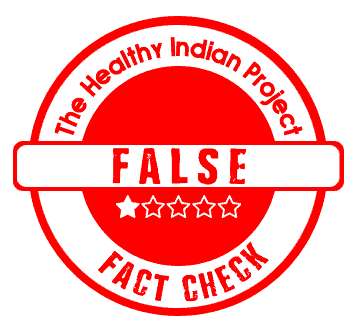Last Updated on January 4, 2024 by Neelam Singh
Quick Take
In an Instagram video, a person claims to have consumed raw chicken with lemon in every meal for eight days, and liking it. He further claims that the store bought chickens are washed with bleaching powder and citric acid. Upon fact-checking, we have determined this assertion to be False.

The Claim
In an Instagram video by Holistic Grenade, he claims to have consumed farm-brought raw chicken daily in every meal for eight days, expressing enjoyment. He asserts that store-bought meat is washed with bleach and citric acid. The video depicts him eating raw meat with lemon.
We have attached a screenshot of the post below:

Fact Check
Why is consuming raw chicken not recommended?
Consuming raw chicken is not recommended due to the potential presence of harmful bacteria, such as Salmonella and Campylobacter. These bacteria can lead to foodborne illnesses with symptoms like nausea, vomiting, abdominal pain, and diarrhea. Cooking chicken thoroughly is essential to eliminate these bacteria and ensure food safety. Raw chicken poses a higher risk of contamination, and the cooking process helps to destroy harmful microorganisms, making the meat safe for consumption. It is a crucial precautionary measure to avoid the health risks associated with consuming undercooked or raw chicken.
What harmful bacteria can be present in raw chicken?
Raw chicken can harbour various harmful bacteria, with two of the most common and concerning ones being Salmonella and Campylobacter. These bacteria can cause foodborne illnesses in humans. Salmonella can lead to symptoms such as diarrhoea, abdominal cramps, fever, and vomiting, while Campylobacter infection may cause similar gastrointestinal issues. Proper cooking of chicken is essential to eliminate these bacteria, ensuring that the meat is safe for consumption. It is crucial to handle raw chicken with care to minimise the risk of bacterial contamination and prevent foodborne illnesses.
How does cooking chicken to a specific temperature contribute to food safety?
Cooking chicken to a specific temperature is crucial for ensuring food safety by effectively eliminating harmful bacteria. The recommended internal temperature for cooked chicken is 165°F (74°C). At this temperature, heat destroys pathogens like Salmonella and Campylobacter that may be present in raw chicken. Adequate cooking not only kills these bacteria but also prevents the risk of foodborne illnesses associated with them. It ensures that the chicken is safe for consumption, minimizing the potential health hazards linked to undercooked or raw meat. Following proper cooking temperatures is a fundamental practice in maintaining food safety standards and protecting consumer health.
What are the potential symptoms of foodborne illnesses caused by raw chicken?

Dr. Swati Dave, Clinical Dietitian and Certified Diabetes Educator (CDE), said, “A variety of foodborne illnesses are present in raw chicken. Consuming raw chicken or its juices can expose you to a variety of bacteria. People must eat chicken that is safely handled, prepared, and cooked properly.”
Foodborne illnesses caused by raw chicken can lead to various symptoms, including:
- Diarrhoea: One of the most common symptoms is the occurrence of loose or watery stools.
- Abdominal Cramps: Pain or discomfort in the abdominal area may occur, often accompanied by cramping.
- Fever: An elevated body temperature is a typical response to bacterial infections.
- Vomiting: Nausea may progress to vomiting, contributing to dehydration.
- Fatigue: General weakness or tiredness may result from the body’s efforts to fight the infection.
- Muscle Aches: Aches and pains in the muscles may occur as part of the illness.
- Nausea: A feeling of queasiness or an inclination to vomit is a common symptom.
- Headache: Some individuals may experience headaches as a result of foodborne illnesses.
Is every store-bought chicken washed with bleach and citric acid?
Not exactly. Not all store-bought chicken is washed with bleach and citric acid. While some chicken processing plants may use these substances as part of their cleaning and disinfection processes, it is not a universal practice. Food safety regulations govern the handling and processing of chicken, and various methods may be employed to maintain hygiene standards. It is better to check product labels or inquire with the store or supplier for specific information about the chicken you purchase to ensure accurate details about its processing methods.
There is a considerable amount of misinformation circulating about meat. We have addressed and clarified numerous myths associated with meat, particularly those suggesting that meat is challenging for humans to digest.
Disclaimer: Medical Science is an ever evolving field. We strive to keep this page updated. In case you notice any discrepancy in the content, please inform us at [email protected]. You can futher read our Correction Policy here. Never disregard professional medical advice or delay seeking medical treatment because of something you have read on or accessed through this website or it's social media channels. Read our Full Disclaimer Here for further information.

